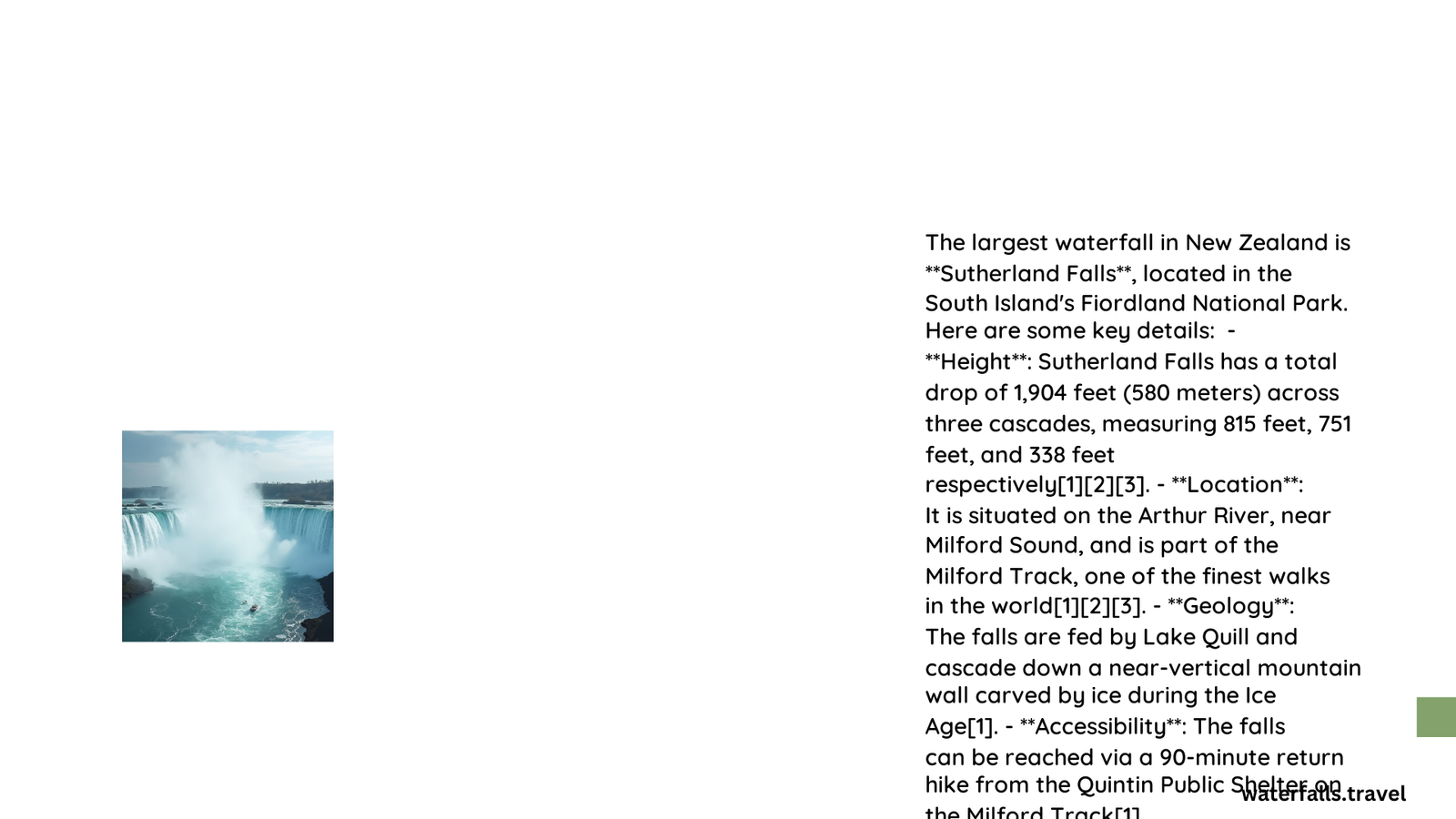Sutherland Falls, located in Fiordland National Park on New Zealand’s South Island, is widely recognized as the country’s tallest waterfall. With a total drop of 1,904 feet (580 meters), it cascades in three distinct leaps from Lake Quill. This majestic waterfall is a highlight of the famous Milford Track and attracts hikers and nature enthusiasts from around the world. While some debate exists about its status as the tallest in New Zealand, Sutherland Falls remains one of the most impressive and accessible high waterfalls in the country.
What Makes Sutherland Falls the Biggest in New Zealand?
Sutherland Falls boasts an impressive three-tiered structure:
- Upper leap: 815 feet (248 meters)
- Middle leap: 751 feet (229 meters)
- Lower leap: 338 feet (103 meters)
This combined height of 1,904 feet makes it one of the tallest waterfalls in the world and the most renowned in New Zealand. However, it’s worth noting that Browne Falls in Doubtful Sound may potentially have a greater total drop, though this is still debated among experts.
Where is Sutherland Falls Located?

Sutherland Falls is situated in the heart of Fiordland National Park, approximately 14 miles (23 kilometers) southeast of Milford Sound. Its remote location adds to its allure and pristine beauty. The falls are fed by Lake Quill, a glacial lake nestled high in the mountains, which ensures a consistent flow throughout the year.
How Can Visitors Access Sutherland Falls?
There are two primary ways to experience Sutherland Falls:
-
Hiking the Milford Track: This is the most immersive option. The falls are encountered on the third day of the 4-day Milford Track hike.
-
Scenic Flights: For those short on time or unable to hike, scenic helicopter or plane flights offer breathtaking aerial views of the falls and surrounding landscape.
What is the Milford Track Experience Like?
The Milford Track is often called the ‘finest walk in the world’. Here’s what hikers can expect:
- Duration: 4 days, 3 nights
- Distance: 53.5 km (33.2 miles)
- Difficulty: Moderate to challenging
- Accommodation: Department of Conservation (DOC) huts or guided tour lodges
Hikers typically start from Te Anau Downs, taking a boat to the trailhead. The side trip to Sutherland Falls occurs on day 3, branching off near Quintin Lodge.
What Should Hikers Prepare for the Sutherland Falls Trek?
Proper preparation is crucial for a safe and enjoyable experience:
- Clothing: Waterproof and warm layers
- Footwear: Sturdy, waterproof hiking boots
- Equipment: Backpack, sleeping bag, cooking gear (if staying in DOC huts)
- Food: Sufficient for the entire trek
- Permits: Advance booking required for the Milford Track
What is the Best Time to Visit Sutherland Falls?
The optimal visiting period is from late October to early May, which is the official Great Walks season. During this time:
- Trails are well-maintained
- Hut facilities are fully operational
- Weather is generally more stable
However, be prepared for rain at any time of year, as Fiordland is one of the wettest regions in New Zealand.
Are There Any Nearby Attractions to Sutherland Falls?
While Sutherland Falls is the main attraction, visitors to the area can also explore:
- Milford Sound: Famous fiord with stunning scenery
- Lake Te Anau: New Zealand’s second-largest lake
- Doubtful Sound: Less crowded alternative to Milford Sound
- Key Summit Track: Offers panoramic views of the Hollyford, Eglinton, and Greenstone Valleys
How Does Sutherland Falls Compare to Other New Zealand Waterfalls?
| Waterfall | Height | Location | Accessibility |
|---|---|---|---|
| Sutherland Falls | 1,904 ft (580 m) | Fiordland National Park | Milford Track or scenic flight |
| Browne Falls | 2,744 ft (836 m) (disputed) | Doubtful Sound | Boat or scenic flight |
| Humboldt Falls | 902 ft (275 m) | Hollyford Valley | Short walk from road end |
| Devils Punchbowl Falls | 430 ft (131 m) | Arthur’s Pass National Park | Easy walking track |
While Browne Falls is sometimes cited as taller, its measurement is disputed due to its gradual descent. Sutherland Falls remains the most iconic and visited high waterfall in New Zealand.
What Conservation Efforts Protect Sutherland Falls?
Sutherland Falls is protected within Fiordland National Park, which is part of the Te Wāhipounamu World Heritage Area. Conservation efforts include:
- Strict visitor management on the Milford Track
- Pest control programs to protect native flora and fauna
- Monitoring of water quality and flow rates
- Education programs for visitors about the area’s ecological importance
By preserving the surrounding ecosystem, these efforts ensure that Sutherland Falls will continue to inspire and amaze visitors for generations to come.
